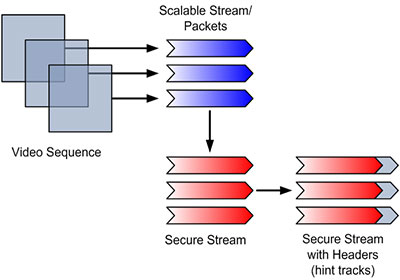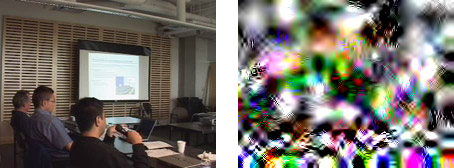:: News
The items on this page represent the Multimedia Lab contributions to the NECTAR News page. Visit the NECTAR News page for all news related to NECTAR.
May 2 , 2006
Secure Scalable Multimedia Streaming
There are two distinct trends emerging in the field of multimedia communications. One is the need for content scalability to enable Universal Multimedia Access (UMA) for varied devices and network conditions. The other is the demand for end-to-end security (e.g., confidentiality and copyright protection), backed up by strong encryption standards. Unfortunately, these two trends have traditionally been considered to be in conflict with each other.
Content scaling is performed by a transcoding operation which requires direct access to the content, ultimately compromising security.
This project, Secure Scalable Multimedia Streaming (SSMS), aims to address this conflict by developing a framework for streaming scalable multimedia, while providing end-to-end security. Previous work performed by HP Labs addressed only secure scaling of video content; SSMS applies the concept to various media, such as slides and documents, as well as video. The framework relies on the content being hierarchically structured using XML and appropriately described using metadata. By encrypting the content, but keeping the structure and metadata in clear-text, a transcoding server can scale the encrypted content without having to decrypt it. Hence, only the receiver with the correct decryption key can access the actual content. Furthermore, this framework may enable complex security policies by matching an encryption key hierarchy with the semantic hierarchy of the content.
Currently, basic framerate scalability of encrypted MPEG-4 (Part 2) video has been implemented. An online proof-of-concept demo is linked at the bottom of the project page. The next milestones are to implement secure, fully scalable H.264 video (AKA MPEG-4 Part 10, or
AVC) and finally MS PowerPoint slides and XML-based documents.

Secure Scalable Multimeda Streaming Project Page »
February 6, 2006
SPIHT-based Coding of the Shape and Texture of Arbitrarily-Shaped Visual Objects

This technical report describes our ST-SPIHT object-based coding scheme which efficiently compresses the shape and texture of arbitrarily shaped visual objects. Arbitrarily-shaped visual objects are digital images which are not necessarily rectangular in shape, allowing semantically meaningful parts of a scene (e.g., a person's face) to be segmented and stored separately. Next generation multimedia systems are expected to be object-based, allowing a variety of new features for content interaction and retrieval, as well as very low bit-rate transmission (i.e., by only transmitting semantically meaningful portions of a scene) targeted toward wireless devices.
Full document — This technical report is the basis for a paper which will be published in the IEEE Transactions on Circuits and Systems for Video Technology journal.
July 14 , 2005
Confidentiality of streamed images and video
While many applications have authentication mechanisms, such as passwords or biometrics, which prevent unauthorized access to the service, they provide no assurance that the communications will be confidential when data is transmitted over untrusted channels such as the Internet and wireless networks. Confidentiality can only be ensured through the use of encryption technologies. However, when streaming images and video in real-time, encryption of the entire media stream becomes too computationally complex. Most computational resources at the server end are consumed for coding/compressing the media stream; at the client end, computational resources are even more limited. To solve this, we have developed a secure coder for still images, based on the principle of partial encryption. Coding and encryption are combined, requiring only a small percentage of the data be encrypted (typically less than 1%). While the most important information is encrypted, the nature of the scheme makes it very difficult for the hacker to locate the unencrypted portion, thus making the entire coded image secure.

The above picture shows the original image (left) and the decoded image without correct decryption key (right). With the correct decryption key, the decoded image retains its full quality without loss of coding efficiency. The scheme depends on using a wavelet-based embedded image coder which results in a data-dependent execution path when coding and decoding the image.
Related Publications:
- K. Martin, R. Lukac, K.N. Plataniotis, "Efficient Encryption Of Compressed Color Images," proceedings of IEEE International Symposium on Industrial Electronics - ISIE 2005, June 2005.
- K. Martin, R. Lukac, K.N. Plataniotis, "Efficient Encryption of Wavelet-Based Coded Color Images," Pattern Recognition, vol. 38, no. 7, pp. 1111-1115, July 2005.